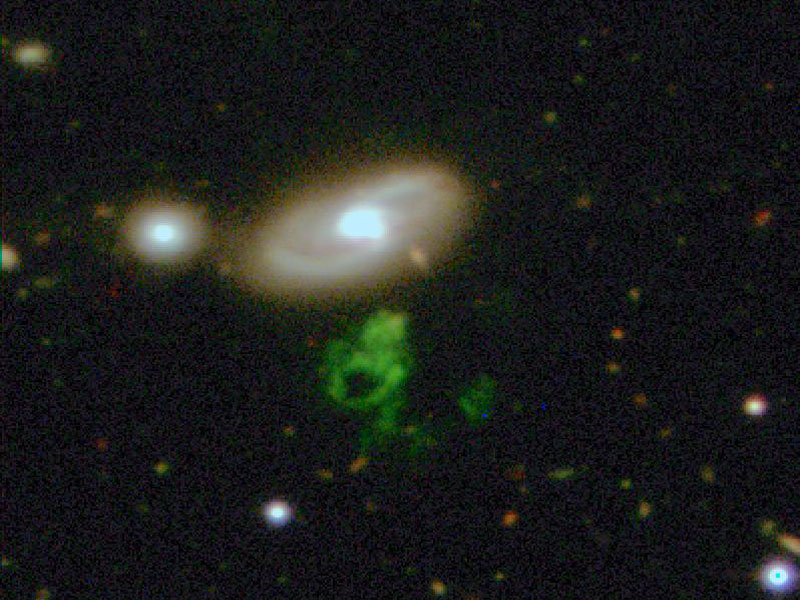
What is Hanny's Voorwerp? Credit: Galaxy Zoo Project, ING
Posted on 06/25/2008 2:22:36 PM PDT by sig226

Explanation: What is that green thing? A volunteer sky enthusiast surfing through online Galaxy Zoo images has discovered something really strange. The mystery object is unusually green, not of any clear galaxy type, and situated below relatively normal looking spiral galaxy IC 2497. Dutch schoolteacher Hanny van Arkel, discovered the strange green "voorwerp" (Dutch for "object") last year. The Galaxy Zoo project encourages sky enthusiasts to browse through SDSS images and classify galaxy types. Now known popularly as Hanny's Voorwerp, subsequent observations have shown that the mysterious green blob has the same distance as neighboring galaxy IC 2497. Research is ongoing, but one leading hypothesis holds that Hanny's Voorwerp is a small galaxy that acts like a large reflection nebula, showing the reflected light of a bright quasar event that was visible in the center of IC 2497 about 100,000 years ago. Pictured above, Hanny's Voorwerp was imaged recently by the 4.2-meter William Herschel Telescope in the Canary Islands by Matt Jarvis, Kevin Schawinski, and William Keel.

The bad guys in Super Mario.

A man in a deep sea diver helmet carrying a gamecock (fighting rooster, not Steve Spurrier)?

I am Gumby, d__nit!

Looks like a frog to me, but that could just be because it’s green. What do I know?

Squint your eyes and look at it. It’s Kermit the Frog. I’ll be that’s where all the frogs go to die. (You did know they have their own place, just like elephants, didn’t you?)
Gumby gas?
lol
Ok looter guy is making far too many cameos these days.

I did not know that.
 Hello, my Honey, Hello my Baby . . .
Hello, my Honey, Hello my Baby . . .
LOLOLOL!! Oh, my gosh! I LOVED that one! (Remember when cartoons were acually FUNNY?)
This is an 8' diameter observatory. It's sitting on a platform that has an independent 8" diameter steel pier that is holding the main optical tube assembly. The pier is not touching the floor, and clears it by 1/4 inch so as not to induce vibrations to the telescope while walking on the floor while inside. The main telescope is a 10" diameter Catadioptric Schmidt Cassegrain which uses a series of mirrors and lenses.
The scope is fully computerized and can be operated from a laptop inside or remotely from my home.
I started out with used equipment, scopes etc, and slowly traded up and eventually purchased some new stuff. I am very much into astronomical digital imaging of deep space objects like galaxies, nebula, and globular star clusters.
It was a big learning curve for me going from film, to digital. Took a long time for me to get to this point due to financial restraints. I am still learning how to process images, in order to bring out all the available data in the images.
The observatory has been a dream of mine for years. Without it, setting up and tearing down the equipment became very tiresome. Now I just go in, flip some switches and whammo, I'm space trucken. Others do much better than I in regards to image quality, but I'm slowly getting there and learning how to bring out all the data while processing the images.
Below is the Whirlpool M-51 Galaxy. This is a digital image, taken recently. This baby is approximately 37 million light years out. It's about half the diameter of our Milky Way Galaxy or about 60 thousand light years in diameter. The larger stars surrounding the galaxy are much closer to us, with the galaxy being millions of light years beyond them.

Hope that helps.
That has got to be one of the coolest things I’ve ever seen. Thanks for taking the time to share!
Thanks. It’s kind of nice to leave this planet once in a while, looking into the past, and seeing the future.
Disclaimer: Opinions posted on Free Republic are those of the individual posters and do not necessarily represent the opinion of Free Republic or its management. All materials posted herein are protected by copyright law and the exemption for fair use of copyrighted works.